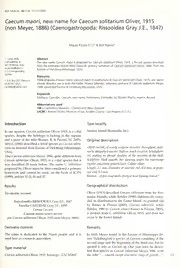
Caecum maori, new name for Caecum solitarium Oliver, 1915 (non Meyer, 1886) (Caenogastropoda: Rissooidea Gray J.E., 1847) PDF
Preview Caecum maori, new name for Caecum solitarium Oliver, 1915 (non Meyer, 1886) (Caenogastropoda: Rissooidea Gray J.E., 1847)
. Boll. Malacol., 42 (1-4): 13-14(2006) Caecum maori, new name for Caecum solitarium Oliver, 1915 (non Meyer, 1886) (Caenogastropoda: Rissooidea Gray IE., 1847) Mauro Pizzini (IS!)* & Bret Raines# * Largodella Abstract Caffarelletta, 6, The new name Caecum maori is proposed for Caecum solitarium Oliver, 1915, a Recent species described 00179 Roma, Italy, from the Kermadec Islands (NewZealand), primary homonym of Caecumsolitarium Meyer, 1886, from the [email protected], Eocene ofVicksburg (Mississippi, USA). (ei)Corresponding Author Riassunto * P.O. Box257, Parsons Viene proposto il nuovo nome Caecum maoriin sostituzione di Caecumsolitarium Oliver, 1915, una specie KS67357 USA, attuale descritta per le Isole Kermadec (Nuova Zelanda), omonimo primario di Caecum solitarium Meyer, [email protected] 1886 specie dell'Eocene di Vicksburg (Mississippi, USA). Keywords Mollusca, Caecidae, Caecum, new name, homonymy, Kermadec Isl., Eastern Pacific, marine, Recent Abbreviations used CM = Canterbury Museum - Christchurch (NewZealand) LACM = Natural History Museum of LosAngeles County- LosAngeles (U.S.A.). Introduction Type locality In our opinion. Caecum solitarium Oliver, 1915, is a valid Sunday Island (KermadecIsl.). species, despite the holotype is lacking in the septum and a piece of the tube (Raines, B. & Pizzini, M. 2005). Original description Meyer, (1886) described a fossil species as Caecum solita- rium onmaterial from Eocene ofVicksburg (Mississippi, «Shell curved, ofnearly uniform diameter throughout, ante- USA). riorlyobliquely truncate. Septum much exserted, hemispheri- Also Caecum solitarium Meyer, 1886, quite different from cal, making an abrupt shoulder at the junction of the shell. Caecum solitarium Oliver, 1915, is a valid species but it Sculpture: Shell smooth, but showing under the microscope was described 29 years before. The name C. solitarium regularconcentricgrowth-lines. Colourwhite. proposed by Oliver must be then considered a primary Length, 2.7 mm. Diameterat anterior end, 0.4 mm; at poste- homonym and cannot be used, on the basis of ICZN riorend, 0.3 mm. (1999), articles52 (1, 4) and 57. Habitat. -Afewdeadshells dredged near SundayIsland." Results Geographical distribution Taxonomic account Oliver (1915) described Caecum solitarium from the Ker- madec Islands, while Rehder (1980) dubitatively exten- Superfamilia RISSOOIDEAGrayJ.E., 1847 ded its distribution to the Easter Island. As pointed out Familia CAECIDAE GrayJ.E., 1850 by Raines & Pizzini (2005), Caecum solitarium sensu Genus Caecum Rehder, 1980 (= Caecum rehderi Raines & Pizzini, 2005), Caecum maori nomen novum is distinct from C. solitarium Oliver, 1915, and does not pro Caecum solitarium Oliver, 1915 (nonMeyer, 1886) occur in the EasterIsland. Derivado nominis Remarks The name is dedicated to the Maori people and it is In 1885, Meyer found in the Eocene of Mississippi (lo- usedhereasanoun inapposition. wer Vicksburgian) a species of Caecum consisting of the second stage and the beginning of the third one, but he Type material quoted it only as Caecum sp. One year later, he descri- bed that species as Caecum solitarium Meyer, 1886, with CM Caecum solitarium Oliver, 1915,holotype - M2867. the tube "... smooth except concentric rings ofgrowth..." Dall (1892) suggested that Caecum solitarium Meyer, 1886 was the second growth stage ofanother annulated fossil species. Caecum alterum Meyer, 1887, also descri- bed from the Eocene ofMississippi (Jackson, USA). This assumption was based on the observation that the be- ginning ofthe third stage ofCaecum solitarium, still atta- ched to the second one, was annulated as in Caecum al- terum. Nevertheless, Meyer's original description and figure clearly show that Caecum solitarium has a smooth tube. Furthermore, the previous assumption of Dali op- poses the drawingofMeyer (1886). Mauro Acknowledgements Pizzini We are grateful to Lindsay Groves (LACM), Felix Lo- & renz (Buseck, Germany), and Marco Oliverio (Rome, Bret Italy) respectively for their bibliographic references and suggestions, and to Paul Scofield (CM) for making Raines Oliver's type materialavailable for study. References Dall W.H., 1892. Contributions to the Tertiary fauna ofFlori- da with especial reference to the Miocene Beds of the Ca- loosahatchie River. Transactions Wagnerfree Institute Science Philadelphia,3 (11): 201-473. Meyer O., 1885. The Genealogy and the age of the species in the Southern Old-Tertiary. American Journal ofScience, Voi. 30 60-72. : Meyer O., 1886. Contributions to the Eocene Paleontology of Alabama and Mississippi. Geological SurveyofAlabama, Bul- letin,1 (2): 63-85. MeyerO., 1887 (1886). BeitragzurKenntnisderFaunadesAl- ttertiàrs von Mississippi und Alabama. Bericht der Sencken- bergischenNaturalGesellschaft:3-22. Oliver W.R.B., 1915. TheMollusco of Kermadec Islands. Tran- sactions and Proceedings ofthe New Zealand Institute, 47: 509- 568. Raines B. & Pizzini M., 2005. Contribution to the knowledge of the Family Caecidae: 16. Revision of the Caecidae of Easter Island (Chile) (Caenogastropoda: Rissooidea Gray J.E., 1847).Iberus,23 (1):49-65. RehderH.A., 1980. ThemarinemollusksofEasterIsland (Isla de Pascua) and Sala y Gomez. Smithsonian Contribution to Zoology, 289 1-167. : Lavororicevutoil6marzo 2006 14 Lavoroaccettatoil25 agosto2006
